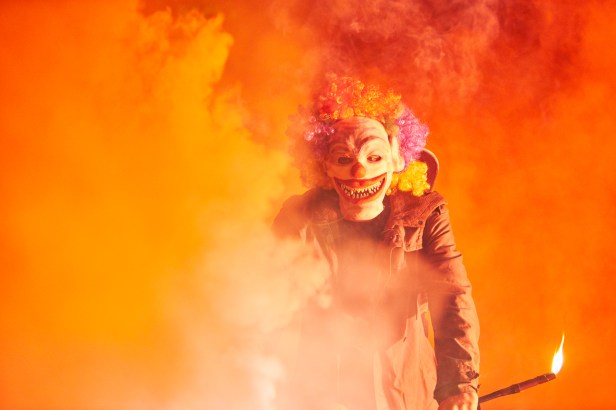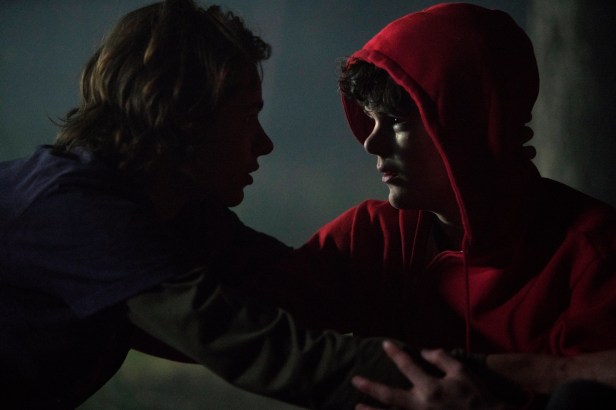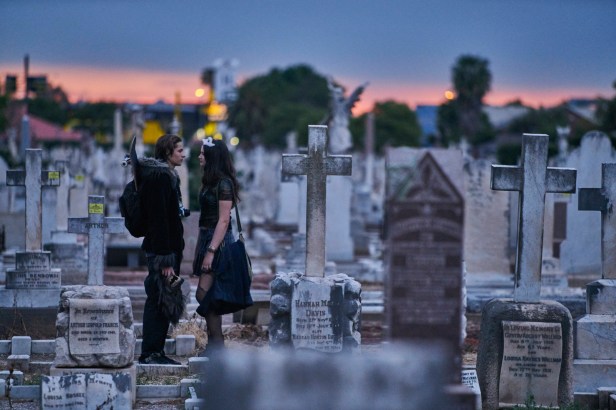Boys in the Trees (2016)
This Halloween not everyone will survive the night.
Set in the late ’90s on Halloween night in a quiet Adelaide suburbia, Boys in the Trees tells the story of graduating high school senior Corey (Toby Wallace), a skater and aspiring photographer. He’s at a point of reassessing his life; torn between his dreams of moving to a bustling city and the current bland reality he shares with his group of cruel friends led by the dominating Jango (Justin Holborow). Also in the mix — vying for his attention — is the mysterious Goth girl Romany (Mitzi Ruhlmann) who shares Corey’s aspirations for something larger than what their little town and crazy colleagues have to offer.
After bullying an old chum and outsider Jonah (Gulliver McGrath), who ends up injuring himself, Corey agrees to accompany his victim home out of sheer guilt and responsibility. As Jango stalks the suburbs looking for his best mate Corey, Jonah is all too interested in taking a slow walk down memory lane, recalling frightening urban stories to remind Corey of the innocent boy he once was, before growing into the young adult bully he has (now) become.

There’s something in the water — South Australian water to be exact. Since The Babadook (2014), we’ve had the kooky Girl Asleep (2015) and now Boys in the Trees, both these flicks dealing with the pains of growing up and accepting responsibility, while using fantasy as a means to challenge and comment on characters and such — ‘magical realism’ in a nutshell. Each one of these films represents a unique take on this growing subgenre in Australian cinema, a willingness to be bold in tone and direction whilst catching the eye of deserving yet different cult audiences.
At this moment, I’d like to really make it clear that despite its marketing campaign, this is not a horror film — Halloween setting and October release date aside — as Boys in the Trees is really a Gothic drama interwoven with playful eeriness, even if it does have its horror-esque moments. That said, I do feel the expectation of ‘scares’ will only damage the true story at the heart of this little movie.
In Boys in the Trees, DJ-turned-director Nicholas Verso makes his feature debut, evoking the same creepy atmosphere and melancholy that he displayed in his excellent short The Last Time I Saw Richard (2014), which was set in a teen mental health clinic and featured his first pairing with growing young talent Toby Wallace, Tim Winton’s The Turning (2013), who stars here, too. I remember watching the said short at a prior festival thinking that 1) it could make for a first-rate feature and 2) Verso was doing something different in the Australian cinematic landscape — delivering a curious Gothic introspection. Given the scale and freedom of the feature format, Verso has really let loose in the most wonderful way here, delivering enough style and substance to warrant a paying audience.

Wearing its influences right on its sleeves, one can easily see the embracing of two iconic films in particular — the punk darkness of The Lost Boys (1987) and the slight cheekiness and glum of Donnie Darko (2001). In Justin Holborow’s gang leader Jango, there’s the channeling of Kiefer Sutherland’s nasty vampire David from the former, while rising talents Toby Wallace and Mitzi Ruhlmann embrace the off-center curiosity of Jake Gyllenhaal’s Donnie Darko and Jena Malone’s Gretchen Moss from the latter.
Also from the Darko influence is strong atmospheric night-time cinematography by Marden Dean, Fell (2014), accompanied by an iconic soundtrack from the ’90s featuring the likes of Marilyn Manson, Garbage and The Presidents of the United States of America. The combination of these certainly does a lot by way of harking back to another time and place, and for anyone growing up in said period, it’s likely to induce nostalgic thoughts and a desire to dig up an old CD or two.
It’s not all throwbacks and style though — at the root of it all is a meditation on growing pains depicted as both an inevitable reality and a conscious choice. The characters introduced in the short urban tales — rendered with campfire-like spookiness by Gulliver McGrath’s cheeky Jonah — have all failed to grow up, each being shackled to their fears, never searching for what they truly desired out of life. Jonah, however, questions the value of adulthood, favoring the innocence and wonder of youth as opposed to the harsh reality of ‘the daily grind,’ while Corey is caught right in the middle, uncertain of the direction he wants to take, just like so many other teenagers today — Toby Wallace delivering a nuanced performance, this confirming him as one of the great talents of his generation. On the other side of the coin, on the firm road to adulthood is Mitzi Ruhlmann’s Romany, who’s clearly done with her adolescent days and is preparing to live in her own world for once. It’s rare to see such thoughts in an Australian movie without being restricted by a hardened ‘gritty’ realistic style, as happens all too often — Blessed (2009) being one such example.

If there were one gripe I had with Verso’s otherwise intriguing direction, it would be his rather static blocking. It may not sound like a problem, but it really feels as though whenever a character is going to talk, they’ll stop completely and with it, so does the film. It’s as if Verso isn’t aware of how to stage these moments and opted for the easiest but least dynamic way of shooting. I’m not suggesting dialogue scenes need to be constantly unfixed, but in the context of Corey and Jonah’s long walk through the surreal night, it actually seems more natural to allow movement between these characters and subsequently more visual interest. By contrast, the montages of Jango’s skater gang — The Gromits — running riot flow with energy and movement, the slow motion creating a dreamy feel, reminiscent of the similarly themed Paranoid Park (2007).
To wit, Boys in the Trees is an audacious addition to a flourishing subgenre, breathing some much needed air of originality into the otherwise conservative Australian cinematic canvas. While teens are likely to enjoy the flick for the most part, it’s fans of its key reference points — The Lost Boys and Donnie Darko — as well as ’90s kids in general, that are most likely going to get a good kick of out of this one.
This Halloween, do make some time for the trees.
3.5 / 5 – Great
Reviewed by Steve Ramsie
Boys in the Trees is released through Mushroom Pictures